


TOUSSAINT LOUVERTURE c1743 -
1803
(G2, G3a,
G3b, G3c)
xxxxxIn 1791, the black slave Toussaint Louverture led a successful
rebellion against the French colonial regime in his homeland of
Saint-Domingue, today's Haiti. However, when the revolutionary
government in Paris abolished slavery in 1794, he supported the
French in driving the Spanish and British from the island. Then in
1801, having freed the slaves in the Spanish territory of Santo
Domingo, he took charge of the entire island as a French
protectorate. But in 1802, Napoleon re-imposed slavery, and
sent a large force to re-conquer the colony. Toussaint's forces
were defeated. He was captured, taken to France, and died in prison
in 1803. Within a year of his death, however, the French had been
routed, and the new black leader, Jean Jacques Dessalines, had
declared Haiti a republic, the first independent nation in Latin
America.
Including:
The Anti-Slavery
Movement

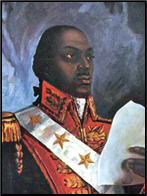
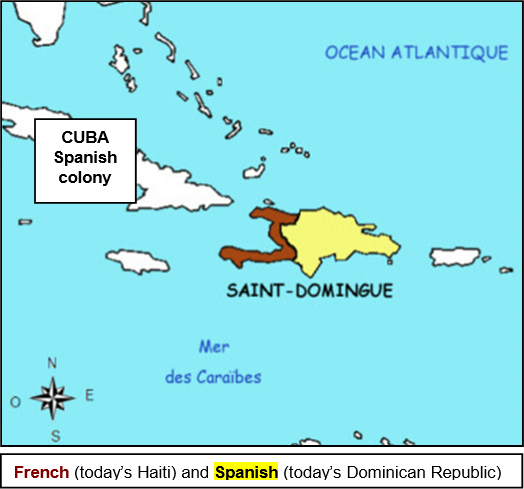 xxxxxThe famous negro Toussaint Louverture was
born a slave in the French controlled part of Saint-Domingue, an
island in the Caribbean (brown on map). Self-educated
and strong willed, in 1791 he joined a black
slave rebellion against the French colonial regime and was soon taking
a leading part in the insurrection as their military commander. After
France abolished slavery in 1794, he was appointed lieutenant governor
in 1795 by the revolutionary government in Paris, and he then
supported the French in driving the British and the Spanish out of
their colony. Then In 1801 he attacked the Spanish territory of Saint-Domingue, freeing the slaves and
becoming ruler of the entire island with the title of governor-general.
xxxxxThe famous negro Toussaint Louverture was
born a slave in the French controlled part of Saint-Domingue, an
island in the Caribbean (brown on map). Self-educated
and strong willed, in 1791 he joined a black
slave rebellion against the French colonial regime and was soon taking
a leading part in the insurrection as their military commander. After
France abolished slavery in 1794, he was appointed lieutenant governor
in 1795 by the revolutionary government in Paris, and he then
supported the French in driving the British and the Spanish out of
their colony. Then In 1801 he attacked the Spanish territory of Saint-Domingue, freeing the slaves and
becoming ruler of the entire island with the title of governor-general.
xxxxxBut his rule over what he
saw as a French protectorate proved short-lived. In 1802
Napoleon re-imposed slavery, and sent a force of 20,000 to re-conquer
the territory. Toussaint's forces were defeated, and he was captured
and later accused of conspiracy. He was taken to France, and died in
prison the following year. Honoured today as one of the founders of
the state of Haiti, and known as "the Precursor", in 1983 his
remains were returned to his homeland and given a ceremonial burial.
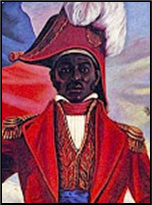 xxxxxIncidentally, within a year
of Toussaint's death, the rebels, assisted by the British and the
ravages of yellow fever, had driven the French out of Haiti, and the
black leader Jean Jacques Dessalines (1758-1806) (illustrated) had declared himself emperor of the republic of Haiti
- the first independent nation in Latin America. Following his
assassination in 1806, rule over the island became divided until
1820. Then in 1844 the eastern side of the island declared its
independence as the Republic of Santo Domingo (today's Dominican
Republic). ...…
xxxxxIncidentally, within a year
of Toussaint's death, the rebels, assisted by the British and the
ravages of yellow fever, had driven the French out of Haiti, and the
black leader Jean Jacques Dessalines (1758-1806) (illustrated) had declared himself emperor of the republic of Haiti
- the first independent nation in Latin America. Following his
assassination in 1806, rule over the island became divided until
1820. Then in 1844 the eastern side of the island declared its
independence as the Republic of Santo Domingo (today's Dominican
Republic). ...…
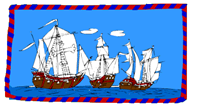 xxxxx...... Christopher Columbus
landed on this island during his second voyage to the New World in
1494. He named it La Isla Española, and
this became anglicized to Hispaniola.
During Spanish colonial times it was often called Santo Domingo,
after the capital city.
xxxxx...... Christopher Columbus
landed on this island during his second voyage to the New World in
1494. He named it La Isla Española, and
this became anglicized to Hispaniola.
During Spanish colonial times it was often called Santo Domingo,
after the capital city.
xxxxxThe French colony of Saint-Domingue,
like much of the New World, owed a great deal of its prosperity to
the slave trade. Towards the end of the 18th century, however, an Anti-Slavery Movement was
gathering pace. In England, for example, Granville Sharp, Thomas
Clarkson and Josiah Wedgwood formed the Anti-Slavery Society in
1787, and William Wilberforce promoted its cause in parliament.
Denmark became the first nation to end its slave trade, and France,
having formed its own anti-slavery society, abolished slavery
in its colonies in 1794, though not permanently. Meanwhile in
America, men like Benjamin Franklin and Thomas Paine were
championing the cause of man's equality. As we shall see, it was in
1807 (G3c) that,
mainly due to the eloquence and determination of William
Wilberforce, the British parliament passed an act prohibiting
British subjects from taking part in the slave trade.
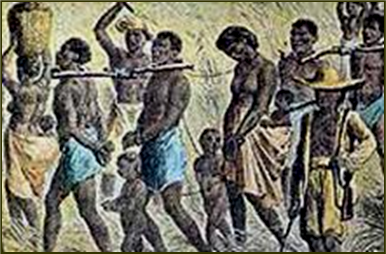 xxxxxDuring the 18th century, the French colony of Saint-Domingue
- rich in sugar, coffee, cocoa, cotton and ebony - became
one of the most prosperous colonial possessions in the New World.
Much of its economic success, however, was due to slavery. It is
reckoned that, over the years, some three million men, women and
children were transported from West Africa and used as forced labour
in the colony. Of these it is estimated that 25,000 died a year,
either during the ghastly outward journey, or because of the hard
working conditions on the estates and plantations.
xxxxxDuring the 18th century, the French colony of Saint-Domingue
- rich in sugar, coffee, cocoa, cotton and ebony - became
one of the most prosperous colonial possessions in the New World.
Much of its economic success, however, was due to slavery. It is
reckoned that, over the years, some three million men, women and
children were transported from West Africa and used as forced labour
in the colony. Of these it is estimated that 25,000 died a year,
either during the ghastly outward journey, or because of the hard
working conditions on the estates and plantations.

xxxxxBy this time, however, a
movement against slavery and the slave trade was gathering pace.
Missionaries in the 16th century, and Quakers
in the 17th century, had spoken out against
such inhumanity, but it was towards the end of the 18th century that
disapproval emerged on a much wider scale. In 1771, for example, the
English humanitarian Granville Sharp (illustrated
top left) persuaded British courts not to
recognise slavery in England. Then in 1787 he joined the Englishmen
Thomas Clarkson (illustrated bottom left) and the famous pottery manufacturer Josiah Wedgwood
in forming the Anti-Slavery Society. In that year it
established Sierra Leone in West Africa as a refuge for the "black
poor of London", and the following year it recruited William
Wilberforce as its spokesman in parliament. He persuaded his friend,
Prime Minister William Pitt, to set up a select committee of the
Privy Council to look into the whole question of the slave trade.
And opposition was not always on moral grounds. Economists, notably
the Englishman Adam Smith in his The Wealth of
Nations, argued that slaves were more expensive to keep
than free labourers, and that the plantation system they helped to
maintain was a wasteful use of land.
xxxxxAnd there was growing
opposition to the slave trade elsewhere. In 1788, for example, the
French abolitionists founded the Society of the
Friends of the Blacks, and six years later the
revolutionary government in Paris abolished slavery in its colonies
- though nor permanently. Denmark, however, was the first
country to outlaw the transatlantic trade, doing so in 1792. In
North America, the champions of American independence - such as
Benjamin Franklin and Thomas Paine - saw no place for slavery
in their concept of a new state where all men were to be equal.
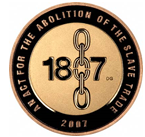 xxxxxIn Britain, as we shall see,
it was mainly due to the eloquence and determination of William
Wilberforce that Parliament passed an act in 1807
(G3c) prohibiting British subjects from
taking part in the slave trade, and four years later made
participation a criminal offence punishable by transportation to a
penal colony. Total abolition came in 1833, just a matter of months
before Wilberforce's death.
xxxxxIn Britain, as we shall see,
it was mainly due to the eloquence and determination of William
Wilberforce that Parliament passed an act in 1807
(G3c) prohibiting British subjects from
taking part in the slave trade, and four years later made
participation a criminal offence punishable by transportation to a
penal colony. Total abolition came in 1833, just a matter of months
before Wilberforce's death.
Acknowledgements
Toussaint:
detail, 19th century, artist unknown – Digital Gallery, New York
Public Library, USA. Map (Saint-Dominigue):
detail of map by Angélique and Charlène –
colleges.ac.rouen.fr/dunant-evreux. Dessalines:
detail, 19th century, artist unknown – said to be taken from a
full-length painted mural in Port-au-Prince, Haiti.
Slavery: date and artist unknown. Sharp: by the English engraver Charles Turner (1774-1857)
1805, from a painting by the English portrait painter Lemul
Francis Abbott (c1760-1802), 1784 – Guildhall Art Gallery,
City of London. Clarkson: detail, by
the Swedish painter Carl Frederik von Breda (1759-1818), 1788
– National Portrait Gallery, London.
G3b-1783-1802-G3b-1783-1802-G3b-1783-1802-G3b-1783-1802-G3b-1783-1802-G3b








 xxxxxThe famous negro Toussaint Louverture was
born a slave in the French controlled part of Saint-
xxxxxThe famous negro Toussaint Louverture was
born a slave in the French controlled part of Saint- xxxxxIncidentally, within a year
of Toussaint's death, the rebels, assisted by the British and the
ravages of yellow fever, had driven the French out of Haiti, and the
black leader Jean Jacques Dessalines (1758-
xxxxxIncidentally, within a year
of Toussaint's death, the rebels, assisted by the British and the
ravages of yellow fever, had driven the French out of Haiti, and the
black leader Jean Jacques Dessalines (1758- xxxxx...... Christopher Columbus
landed on this island during his second voyage to the New World in
1494. He named it La Isla Española, and
this became anglicized to Hispaniola.
During Spanish colonial times it was often called Santo Domingo,
after the capital city.
xxxxx...... Christopher Columbus
landed on this island during his second voyage to the New World in
1494. He named it La Isla Española, and
this became anglicized to Hispaniola.
During Spanish colonial times it was often called Santo Domingo,
after the capital city.  xxxxxDuring the 18th century, the French colony of Saint-
xxxxxDuring the 18th century, the French colony of Saint-
 xxxxxIn Britain, as we shall see,
it was mainly due to the eloquence and determination of William
Wilberforce that Parliament passed an act in 1807
(G3c) prohibiting British subjects from
taking part in the slave trade, and four years later made
participation a criminal offence punishable by transportation to a
penal colony. Total abolition came in 1833, just a matter of months
before Wilberforce's death.
xxxxxIn Britain, as we shall see,
it was mainly due to the eloquence and determination of William
Wilberforce that Parliament passed an act in 1807
(G3c) prohibiting British subjects from
taking part in the slave trade, and four years later made
participation a criminal offence punishable by transportation to a
penal colony. Total abolition came in 1833, just a matter of months
before Wilberforce's death.

